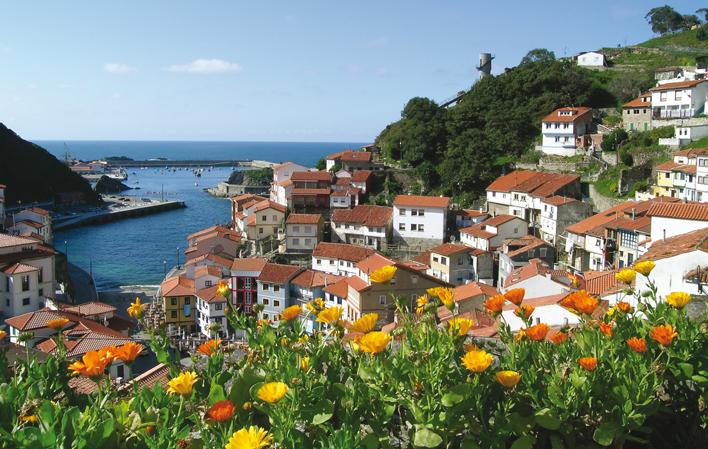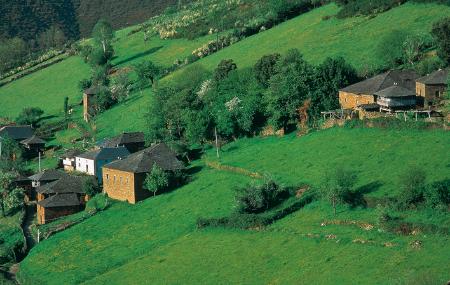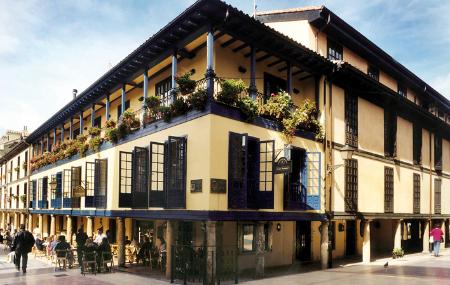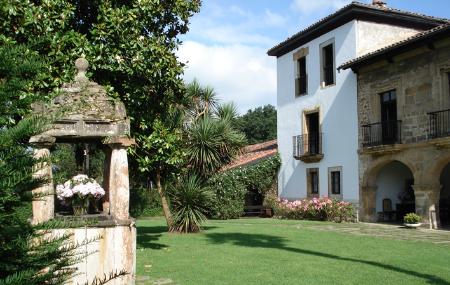
- Address Castropol, Coaña, Cudillero, Gijón, Oviedo, Lena, Langreo, Siero, Sariego, Villaviciosa, Colunga, Cangas de Onís, Llanes From east to west
- Distance Distance: 232 kms
- Cars Cars: 7 days
- Start point Start point: Orillas del Eo
- Route type Route type: coche
- Layout of the route Layout of the route: Download kml
A journey back in time through Asturias, visiting its architectural heritage which both traces the past and offers an example of what the region is today.
It is possible to travel both through space and time when touring Asturias. This is because, from east to west, from the coast to the inland areas, the region's architectural heritage becomes the tracks of the past and an example of what the region is today. The proposed route has a logical territorial order, although its sections are perfectly interchangeable to suit each individual traveller.
Orillas del Eo - Castropol - Coaña - Luarca - Cudillero - Avilés - Gijón - Oviedo - Lena - Langreo - Siero - Sariego - Villaviciosa - Colunga - Cangas de Onís - Llanes
Day 1: Castropol - Villacondide - Luarca 61,8
Day 1: The architecture route begins on the banks of River Eo, in the borough of Castropol. In this strategic situation stands Peñalba Mansion. Built in 1912 as a summer house by the widow of an Indiano (the name given to returning Asturian emigrants who had made their fortune in the Americas), is a fine example of art nouveau in Asturias. The Pardo Donlebún Mansion is also found in Castropol, The oldest parts of the mansion's gardens date from the 16th century. Next stop: hill fort culture. A half hour's drive to the east and just 7 kilometres from Navia, in Villacondide, brings you to the site of Coaña Hill Fort, which preserves 80 stone huts protected by a thick surrounding wall and a moat excavated in the rock, a settlement dating back to the 4th century BC. Before you get to Villacondide, you have the chance to see another example of this type of settlement in the hill fort of Mohías, which you reach by taking the N-634 in the vicinity of Jarrio. Luarca constitutes a staging point. In addition to its natural amphitheatre overlooking the sea, the Villar neighbourhood is dotted with some of the best examples of the Indiano style, such as the Argentina, Excelsior or Barrera and Casa Guatemala villas.
Day 2: Luarca - Avilés 71
Day 2: The journey continues along the coast to Soto de Luiña. In this village belonging to the borough of Cudillero, with easy access from the Autovía del Cantábrico dual carriageway, can be found the Church of Santa María and its rectory, which was a former pilgrim hospital. This 18th-century complex is a listed Property of Cultural Interest. A quarter of an hour away, at El Pito, just outside the town of Cudillero, travellers can enjoy a visit to the Selgas Estate, which requires prior booking to open its doors. Its outside appearance mirrors the style of traditional 16th-century Italian villas, though it was built in the 19th century. Inside it displays a unique collection of art bequeathed by the Selgas-Fagalde family to people of Asturias. From the charm of classicism to the modernity of the Oscar Niemeyer International Cultural Centre in Avilés. The complex, comprising three different buildings laid out in a white public plaza, was designed by the Brazilian architect. He subsequently donated the design to the Principality of Asturias. Also worth visiting in this city are the Marketplace, designed in the Modernist style by the Orbón Brothers, and Plaza de Las Aceñas, as well as the old quarter, which is a listed Historic-Artistic Site, with the characteristic arcades of Galiana Street.
Day 3: Avilés - Gijón 67
Day 3: Gijón and its Roman remains are the focus of attention today. In the outskirts of Gijón, to the west, is La Campa Torres Archaeological-Nature Park. This spot, located on a scenic balcony overlooking the sea, consists of three buildings: the reception centre, museum and lighthouse. The visit revolves around the remains of an ancient coastal hill fort, which dates back to the 6th century BC Heading on to the city centre, the Campo Valdés Roman Baths can be found at the end of the beach of San Lorenzo, next to the Church of San Pedro. Apart from its archaeological heritage, the city has beautiful buildings such as Revillagigedo Palace and the Birthplace of Jovellanos, both near the town square, and El Bibio Bullring. Just 20 minutes from the city centre, Veranes preserves the remains of a Roman settlement. The visit to the site, which is fully accessible, displays archaeological remains of a 4th-century AD villa that was built over an earlier settlement. East of the city centre, the traveller finds the Laboral, City of Culture, an imposing complex occupying some 27,000 square metres, now partially restored for cultural and educational purposes.
Day 4: Gijón - Oviedo 41,4
Day 4: Rising high above Oviedo's skyline stands the Cathedral bell tower and the "visor" of the Convention Centre designed by Calatrava. They are the two highest points in the city, the past and the present, which catch the traveller's eye. San Salvador Cathedral was begun in the 13th century on the site of an older, Pre-Romanesque church. The works lasted three centuries, so it includes remains of the Romanesque, Gothic and Baroque styles. The cathedral is nestled in the old quarter, where visitors can take a tranquil stroll around its pedestrian streets. The Convention Centre designed by Calatrava is one of the most unique buildings in the city and is located in the district of Buenavista. Opened in 2011, it houses a shopping centre, auditorium, hotel and administrative office space. However, the most representative form of architecture in Oviedo is its Asturian Pre-Romanesque, a style that developed between the 8th and 10th centuries, which can be seen in La Foncalada Fountain and the Churches of San Julian de los Prados, San Miguel de Lillo and Santa María del Naranco. The first two are located within the city. To visit the last two, you need to head up to Mount Naranco, which also houses a reception and interpretation centre (check opening times beforehand) .
Day 5: Oviedo - Lena - Langreo 84
Day 5: The mining valleys open up to the south, where much more than coal can be found. Some 36 kilometres south of Oviedo on the A-66, Santa Cristina de Lena constitutes one of the finest examples of Pre-Romanesque. The Church of Santa Cristina was built in the mid-9th century and stands on a hill with spectacular views. Returning north on the A-66, you can take the turning to Ujo and Turón to then head for Bustiello mining village, a small model village built between 1890 and 1925 by the Hullera Española coal company, which has been restored. There you can visit the church, the old social club, the sanatorium and the houses, built following the Mulhouse model of social housing, which received an award at the Paris Exposition in 1867. The Autovía Minera or Mining Valleys Dual Carriageway, which starts in Mieres, takes you to Langreo, where you can see another example of architecture linked to coal mining: Samuño Ecomuseum, at the former San Luis Pit. These facilities are in the village of El Caldavíu (Ciaño) and include the experience of a 2-kilometre ride on an old mining train. Although the borough also boasts other more current examples, such as Juan Carlos Beiro Sports Centre, whose original design, nestled in the heart of the industrial heritage of the mining valleys, has received several awards.
Day 6: Langreo - Pola de Siero - Colunga - Arriondas 103
Day 6: The architecture route continues eastward with a first stop in Pola de Siero to enjoy the marketplace, designed by engineer Ildefonso Sánchez del Río. The uniqueness of the market, built in 1930, lies in the shape of its domed roof and an inside that is raised without a single column. The possibilities multiply to the east. If you head out of Pola de Siero on the N-634, you can visit the Romanesque churches of San Esteban, in Aramil, and of Santiago and Santa María de Narzana, both in Sariego. If, however, you choose to take the Autovía del Cantábrico dual carriageway towards Santander, you will soon reach Villaviciosa and, from there, Valdedios on the AS-267 regional road. The aim of this detour is to contemplate the Monastery of Santa María La Real and the small convent called "El Conventín", another example of Pre-Romanesque heritage. Back on the dual carriageway, the journey continues on to Colunga where you can find the Pre-Romanesque Church of Santiago de Gobiendes, 4 kilometres outside the borough capital. From Colunga, you can return inland over El Alto del Fito to reach Arriondas. At the top, you will be surprised by the original design of its scenic balcony, opened in 1927.
Day 7: Arriondas - Cangas de Onís - Llanes - Colombres 72
Day 7: Following a stroll around Arriondas, on the banks of the River Sella, through the town's unique squares, the last day of the tour begins. The first stop is in Cangas de Onís, to the Monastery of San Pedro de Villanueva, built on pre-Roman ruins in the 8th century and now converted into a parador luxury hotel. You cannot leave the area without visiting the centre of Cangas and its "Roman" bridge, a structure which, curiously, is so named after this style, but actually dates from a later time. The route continues on to Llanes (50 minutes' drive), which means it is necessary to return to Arriondas to take the N-634 that will take you back onto the Autovía del Cantábrico dual carriageway or continue on the AS-114 and AS-115 along a much more scenic route. In the town of Llanes village, you can walk inside its medieval historical-artistic quarter and also compare this setting with more modern buildings like the social club (casino), inspired by Indiano architecture. Asturians emigrants to America were part of the beginning of the trip and will be part of its final stretch. The Indianos Archives opened its doors in Colombres, Ribadedeva, in the Guadalupe Estate, a truly beautiful setting.




